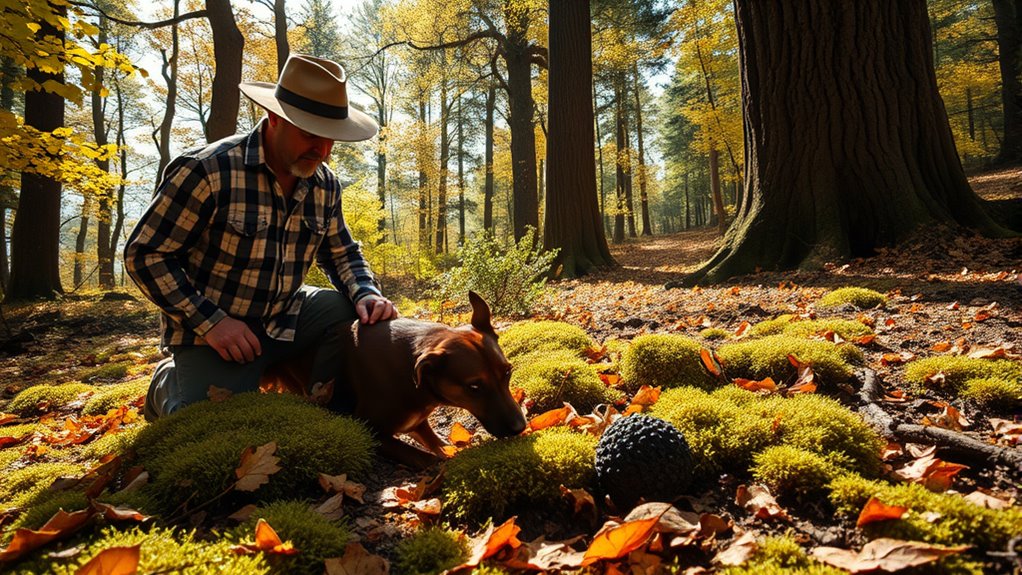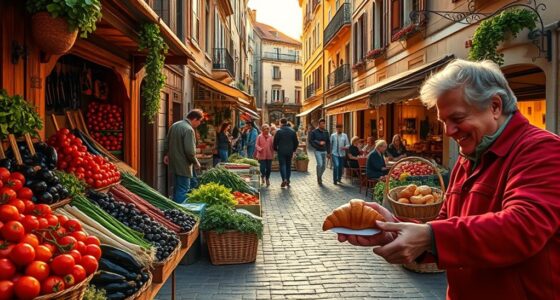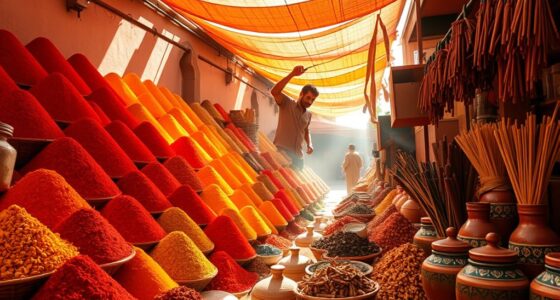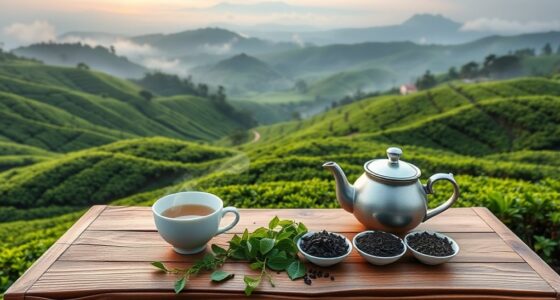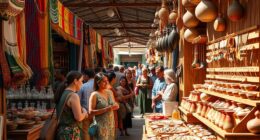Begin an exciting Italian truffle season adventure by exploring centuries-old traditions and regional flavors. Join skilled hunters with trained dogs in forests rich in limestone soil, hunt for the prized white and black truffles, and experience vibrant festivals that celebrate this gastronomic treasure. The best times are from September to December, with markets buzzing and culinary delights awaiting. If you continue, you’ll uncover how to turn this exquisite bounty into unforgettable experiences.
Key Takeaways
- Experience traditional truffle hunting by trained dogs in Italy’s renowned regions like Alba and Tuscany.
- Participate in seasonal festivals with guided hunts, tastings, and cultural celebrations celebrating Italy’s truffle heritage.
- Learn about sustainable harvesting techniques that protect ecosystems while pursuing prized white and black truffles.
- Discover the best times from September to December for white truffles and November to March for black varieties.
- Enjoy culinary adventures by sampling freshly shaved truffles in regional dishes and exploring local markets.
The Rich Heritage of Italy’s Truffle Seasons

Italy’s truffle seasons are more than just a time for harvest; they embody a rich cultural heritage passed down through generations. Mythical origins and folklore stories weave into the tradition, with tales tracing back to Roman times when truffles were believed to have divine qualities. These stories are shared orally within communities, preserving a sense of identity and history. Skills for finding truffles are handed down through hands-on teaching, often from father to son, alongside rituals that mark the start and end of the season. Folklore stories about mystical animals or ancient legends add charm and mystique to the practice. Heritage preservation plays a significant role in maintaining this living tradition, especially as it is inscribed in 2021 on the UNESCO Representative List of the Intangible Cultural Heritage of Humanity, celebrating and reinforcing this cultural bond, making truffle hunting a living tradition rooted in Italy’s deep historical and mythical roots.
Top Regions for Truffle Hunting and Their Unique Flavors

You’ll find that Alba in Piedmont is famous for its exquisite white truffles, especially during the lively festival in autumn. Meanwhile, Tuscany offers a rich variety of black truffles, known for their hearty, earthy flavor in traditional dishes. Exploring these regions lets you experience the distinct tastes that define Italy’s truffle heritage. Tuscany’s truffle towns in Tuscany boast a diverse landscape of forests and hills that provide the perfect environment for truffle cultivation, attracting enthusiasts and gourmets alike. The unique climate conditions in these areas contribute significantly to the development of truffle flavors, making each region’s harvest uniquely treasured.
Alba’s White Truffles
Alba’s white truffles, known as Tuber magnatum Pico, thrive in the wooded hills of southern Piedmont, especially in the Langhe, Monferrato, and Roero regions. The unique terroir, combining soil composition, climate, and tree roots like oak and hazelnut, creates the perfect habitat. Here’s what makes Alba’s white truffles exceptional:
- The truffle aroma is intensely musky, earthy, with hints of garlic and shallots, setting them apart.
- The soil composition—rich in calcium and limestone—supports the development of their signature flavor.
- Truffle habitats are located within about 45 minutes from Alba, in wild forest patches.
- The tree species and undisturbed woodland environment foster the soil conditions essential for growth. The microclimate also plays a crucial role in enhancing their aroma and flavor profile, further influenced by the soil and climate conditions that are unique to the region.
This combination produces the region’s prized, pungent white truffles, celebrated worldwide.
Tuscany’s Black Truffles
Tuscany stands out as a prime destination for black truffle hunting, with several regions renowned for their rich truffle heritage. In San Miniato, festivals celebrate the region’s prized black truffles, known for their intense aroma and delicate peppery taste. Mugello, Crete Senesi, and Casentino Valley mainly yield white truffles but also host black truffles during specific seasons. Maremma Grossetana’s sandy soil allows summer growth, extending the harvest timing outside typical seasons. The Val Tiberina area, spanning Tuscany and Umbria, hosts autumn festivals focused on black truffles, highlighting their peak harvest from September to March. Black truffles emit a powerful aroma, and their unique flavor varies subtly across regions, influenced by soil and microclimate. Truffle cultivation in Tuscany has become increasingly sophisticated, combining scientific methods with traditional knowledge to improve yields. This regional diversity makes Tuscany a true black truffle haven.
Celebrating With Truffle Festivals and Fairs Across Italy

Italy’s rich truffle heritage comes alive through vibrant festivals and fairs held across its regions each autumn. These events celebrate the prized white truffle (Tuber magnatum) with activities that highlight the truffle aroma and showcase harvest techniques. When you attend, you can:
- Experience truffle auctions and tasting sessions that emphasize their unique scent.
- Participate in cooking competitions that highlight regional recipes.
- Explore guided truffle hunts, learning about traditional harvest techniques.
- Engage in cultural events and learn how festivals blend tradition with innovation. Additionally, the Alba White Truffle Fair has evolved to include sustainable measures, such as adjusting the truffle hunting season to October 1 – January 31, to protect local ecosystems and promote biodiversity environmental protection. These initiatives underscore Italy’s commitment to biodiversity preservation, ensuring future generations can enjoy these culinary treasures.
Major festivals like Alba’s International White Truffle Fair and San Miniato’s Truffle Exhibition attract visitors worldwide. These celebrations promote regional identity while boosting local economies, showcasing Italy’s passion for truffles.
How Climate and Terrain Influence Truffle Growth
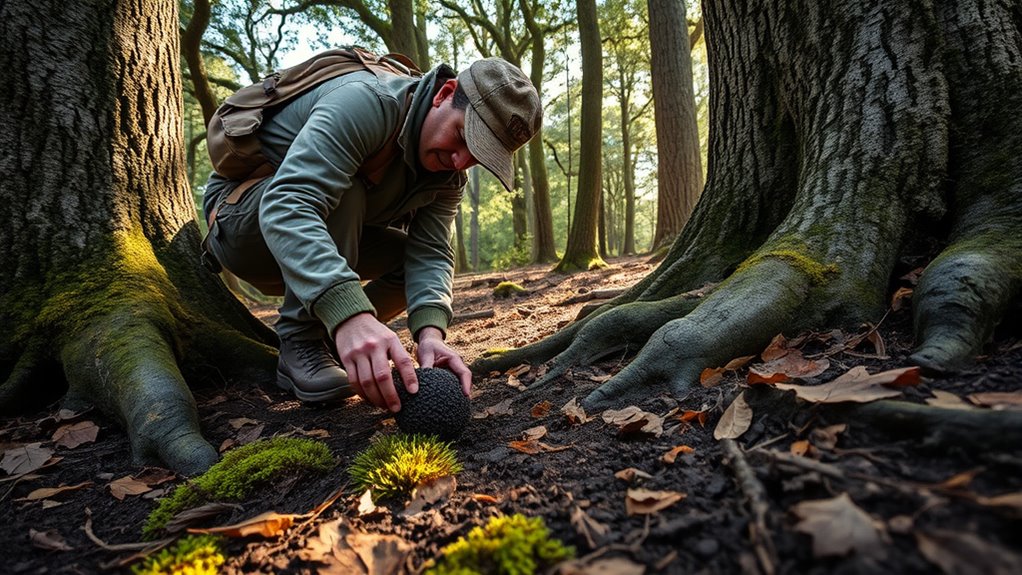
Climate and terrain play a pivotal role in shaping truffle growth, influencing where and when these prized fungi develop. Soil health is essential; well-drained, oxygen-rich soils promote healthy mycelium expansion, while compact or clayey soils hinder development. Temperate winters and consistent soil moisture during autumn and spring support fruiting, but waterlogging causes mold and disease. Extreme summer temperatures above 35°C damage fungal growth, and prolonged droughts halt production. Terrain offering microclimatic stability benefits truffle development, especially when host tree roots remain healthy. Climate resilience is indispensable, as increasing droughts and temperature fluctuations threaten future yields. Rising global temperatures and reduced rainfall are negatively impacting production, especially in France and Italy. Adaptation strategies must focus on maintaining soil health and managing environmental changes to sustain truffle habitats and guarantee consistent harvests. Additionally, implementing climate-resilient cultivation practices can help mitigate the adverse effects of changing weather patterns on truffle yields.
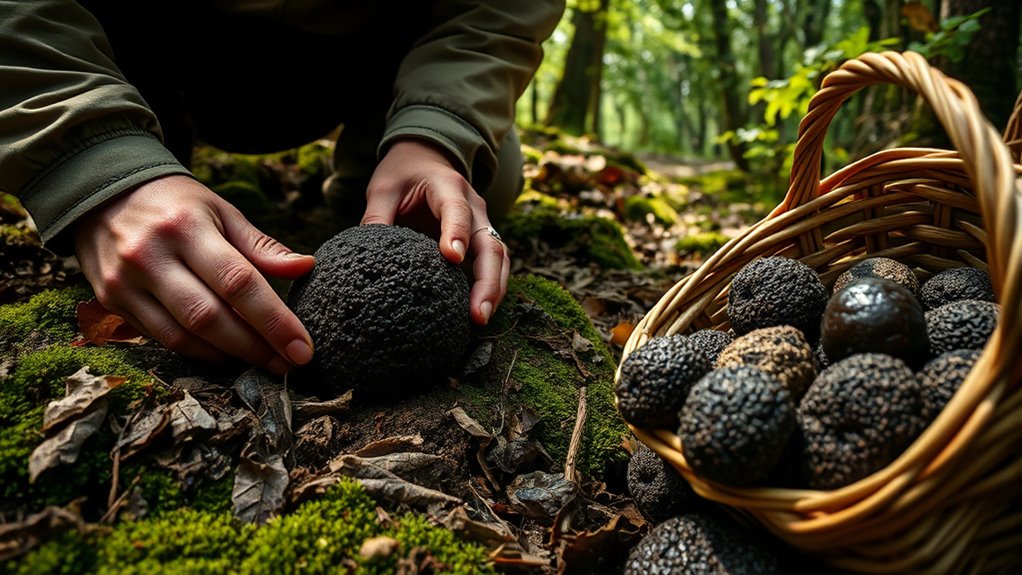
Timing your truffle hunt is key to securing the best quality and prices. Seasonal fluctuations heavily influence market timing, so knowing when to buy can save you money and guarantee freshness. Consider these strategies:
- Hunt during peak seasons—late September to December for white truffles and November to March for black varieties—for top quality and higher prices.
- Purchase early in the season to access premium truffles, but expect to pay more.
- Shop later in the season—around February or March—to find more affordable options, though truffles may be less fresh.
- Visit local markets or fairs for direct deals with farmers, often offering better prices than retail outlets. Market dynamics play a crucial role in determining supply and demand, influencing prices and availability.
The market’s growth rate has been accelerating, indicating increasing demand and supply chain efficiency.
Understanding market timing helps you get the best truffles at ideal prices, making your hunt both successful and satisfying.
The Art of Truffle Hunting: Dogs, Techniques, and Traditions

Truffle hunting combines time-honored traditions with modern techniques, creating a fascinating blend of culture and skill. Mythical folklore often speaks of enchanted forests where spirits guide hunters, reflecting rural craftsmanship passed down through generations. Your success depends on identifying truffle-rich areas, a skill rooted in environmental knowledge and ecosystem management. The bond between hunter and dog, especially breeds like the Lagotto Romagnolo, is central; dogs are trained through positive reinforcement to detect truffle scents underground. Techniques involve delicate tools like the vanghino to minimize soil disturbance and protect the ecosystem. Nighttime hunts take advantage of stronger scent emissions, while understanding local microclimates ensures sustainable harvesting. These practices honor centuries of tradition, blending folklore with precision to sustainably uncover Italy’s prized treasure.
Culinary Delights: Incorporating Fresh Truffles Into Italian Cuisine

Incorporating fresh truffles into Italian cuisine elevates simple dishes to luxurious culinary experiences by highlighting their delicate aroma and earthy flavor. To maximize their impact, consider these techniques:
- Truffle pairing: Thinly shave fresh truffles over pasta, risotto, or soups just before serving to preserve their aroma.
- Culinary presentation: Use melted butter or cream as a flavorful carrier, creating a rich, smooth base that complements the truffle’s earthiness.
- Complementary ingredients: Combine truffles with subtle dairy like Parmesan or butter to enhance their muskiness without overpowering.
- Regional inspiration: Highlight regional variations, such as white truffle tagliolini from Tuscany or black truffle pasta from northern Italy, emphasizing simplicity and freshness for authentic flavor.
The Economic Impact of Truffle Trade on Local Communities

The trade of truffles considerably boosts local economies by providing income and employment opportunities, especially in rural communities. Truffle exports in Italy reached around €63 million in 2018, with growing international demand, supporting economic diversification and rural development. Local hunters, earning between €1,498 and €14,585 annually, contribute profoundly to these economies, offering alternative livelihoods. Many transactions remain informal, but their impact on household income is essential for rural vitality. Additionally, truffle tourism attracts visitors to harvest experiences, festivals, and culinary events that create seasonal jobs and promote small businesses. This not only preserves regional gastronomic identities but also helps counter urban migration. As global interest expands, the truffle trade increasingly becomes a cornerstone of rural development and economic resilience. The growing global demand for truffles further encourages sustainable harvesting practices and investments in local infrastructure.
Sustainable Practices and Innovations in Truffle Harvesting
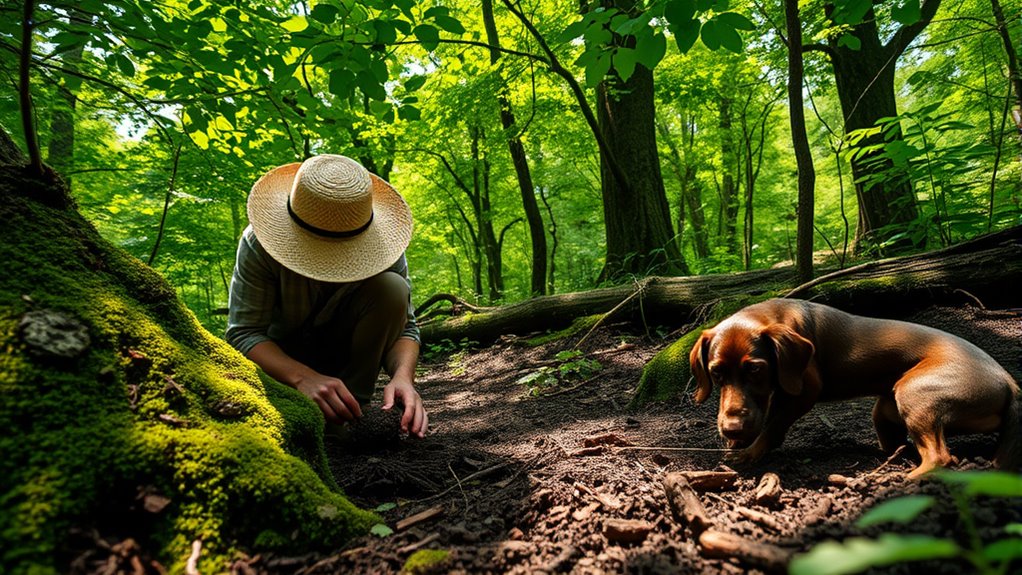
Sustainable practices in truffle harvesting have evolved to balance economic benefits with environmental preservation. You can now utilize eco friendly harvesting techniques alongside technological advancements to minimize habitat disruption. For example:
- Soil monitoring sensors provide precise data, enabling minimally invasive collection.
- Digital mapping targets truffle-rich zones, reducing unnecessary soil disturbance.
- Tracking devices help locate productive areas while protecting ecosystems.
- Harvesting only ripe truffles and covering extraction holes promotes spore dispersal and regrowth.
- Regular assessment and rotation of harvesting sites help maintain the health of truffle habitats, aligning with responsible land management principles.
Planning Your Truffle Adventure: Tips for an Authentic Experience
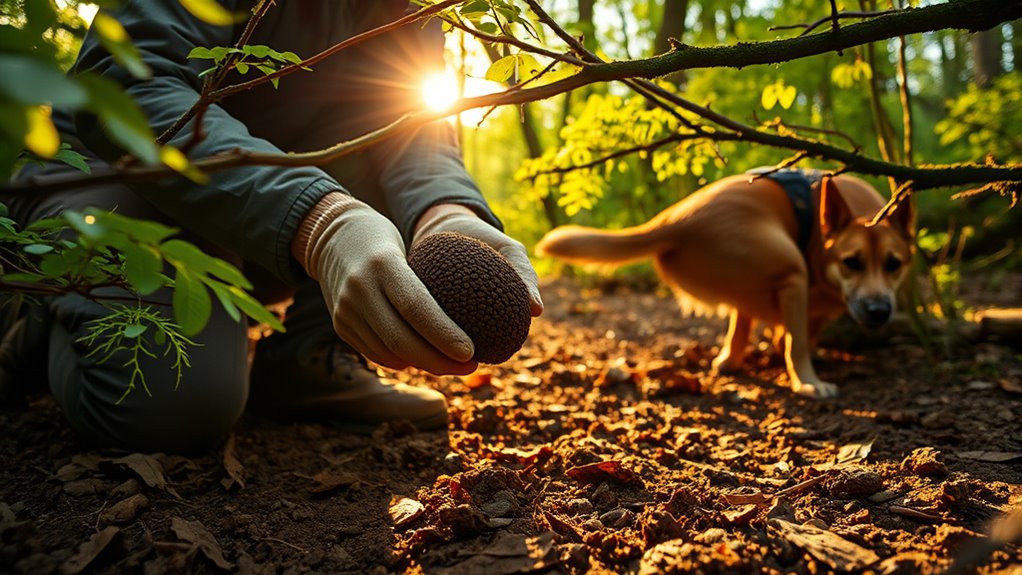
Choosing the right location is essential for an authentic truffle hunting experience, as regions with a rich tradition of foraging offer the best chances to find prized fungi. Top spots like Tuscany, Piedmont, and Umbria provide expert guides, trained dogs, and local knowledge rooted in truffle cultivation techniques. To deepen your experience, learn basic truffle sensory analysis—distinguishing quality, aroma, and texture—before heading out. Opt for areas with a strong foraging heritage, like San Miniato or Gran Sasso, for cultural immersion and expert guidance. Seasonal timing also matters; plan your trip during peak white truffle seasons in autumn or February. Early booking guarantees availability, and respecting environmental practices maintains the grounds’ sustainability, preserving this culinary treasure for generations. Incorporating knowledge of truffle harvesting techniques can also enhance your understanding and appreciation of the process.
Frequently Asked Questions
How Do I Participate in a Truffle Hunting Tour in Italy?
To participate in a truffle hunting tour in Italy, start by choosing a reputable provider that offers local guide selection. Book your tour in advance, ensuring you meet the requirements for truffle hunting gear, like sturdy shoes and weather-appropriate clothing. Arrive on time, and be ready to learn from experienced guides and their trained dogs. Enjoy the experience, discovering hidden truffles and immersing yourself in Italy’s rich culinary traditions.
What Are the Best Months to Buy Authentic Italian Truffles?
Imagine uncovering Italy’s hidden treasure—authentic truffles—at just the right moment. The best months to buy depend on seasonal variations and regional differences; autumn, especially November, offers prime winter white and black truffles, bursting with aroma. Spring and summer bring summer varieties, milder but still exquisite. Act now, as freshness fades quickly, and timing is key to savoring Italy’s gourmet gold at its peak.
Are Truffle Hunting Experiences Suitable for Children or Beginners?
You might wonder if truffle hunting experiences are suitable for children or beginners. They are indeed family-friendly activities and beginner-friendly tours, especially when short, guided outings are involved. Kids enjoy interacting with trained dogs and exploring nature, while adults appreciate learning about truffle ecology. Keep safety in mind, supervise children closely, and choose less challenging terrains. This way, everyone can have a fun, educational, and memorable experience.
How Can I Tell a High-Quality Truffle From a Lower-Grade One?
Imagine you’re tasting a rare jewel; its brilliance reveals the story of its craft. To spot high-quality truffles, examine their shape—rounded with well-defined lobes—and verify they’re firm, with a rich aroma matching their species. Truffle grading considers size, surface cleanliness, and minimal soil residue. A premium truffle showcases distinct flavor profiles, vibrant interior marbling, and no damage, signaling its superiority over lower-grade options.
What Are Traditional Italian Dishes That Prominently Feature Fresh Truffles?
You’ll find that traditional Italian dishes highlight fresh truffles through simple yet luxurious preparations. Dishes like pasta with butter, Parmigiano-Reggiano, and thin slices of fresh truffle showcase their aromatic richness. To preserve their flavor, chefs add fresh truffles at the end of cooking, respecting truffle cultivation and highlighting their delicate aroma. These dishes emphasize truffle preservation, ensuring each bite delivers the full depth of this prized ingredient.
Conclusion
Beginning a truffle hunt in Italy isn’t just a culinary adventure—it’s a journey into centuries-old traditions. With Italy producing over 70% of the world’s prized white truffles, you’re part of a rich heritage that balances flavor, culture, and sustainability. So, plan your trip during peak seasons, embrace local festivals, and savor every bite. This experience will leave you appreciating Italy’s treasure trove of gourmet gold even more.
